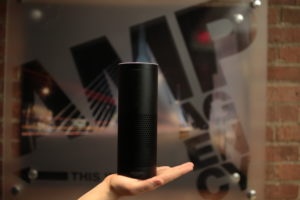
Two trends I’ve continued to follow throughout the years are the need for deeper connections and control without confusion. I believe these two needs have driven technology to this point. The move from text chat, to video chat to VR/AR, is logical in this context. With more technology comes more things and with more things more confusion. I think we’re still in the beginning phases of an IoT revolution but the technology to properly manage and control these experiences was not ready, until now.
What Is An Intelligent Personal Assistant?
Right now I’m focusing on the big 4; Google Assistant, Alexa, Cortana, and Siri. IPAs are conversational bots that help you complete tasks. The bots offered by each of the big 4 have slight differences between them, however, I think they compliment each other well. We’re also slowly starting to reach a point of stabilization where functionality is relatively similar across each platform.
IPAs at the most basic level allow you to get answers to questions very fast.
“How cold is it outside?”
“Who is the oldest person in the world?”
“Why do people still use QR codes?”
Now give your assistant access to things like your phone and calendar, and it becomes a powerful tool to keep yourself organized. Add your credit card, and you can buy toilet paper in fewer words than a haiku. The more it knows about you, the more helpful if becomes.
How Should Marketers Approach Intelligent Personal Assistants
There is a lot of movement in the space right now, so the most important thing you can do is pay attention. Privacy concerns are still top of mind with reports of IPAs ordering things because the TV told them too. The IPAs are also getting new features daily with services popping up to do everything from order Ubers to Pizza. You may have heard a lot about Alexa coming off CES this past year but did you know Google just automatically enabled Google Assistant across all Android phones running the most recent version of the operating system? This is a huge move and instantly brings Google Assistant up to Alexa’s level although Alexa has had a huge head start to get up and running.
But in case you missed the boat, I’ll do my best to get you up to speed on the things Marketers should be paying attention to.
Being First To Market
The most obvious one is the massive opportunity this new marketplace presents. First, to market services will enjoy the luxury of claiming their turf for premium user queries related to their industry. Getting a ride and ordering pizza were two of the first services created by Uber and Dominos on Google Home when it finally added the option for third party integrations.
Although at this point, Domino’s can’t claim “pizza” as the keyword trigger for the app and instead has to use the more direct “Domino’s”, It won’t be long before your Intelligent Personal Assistant remembers that Domino’s is your favorite place to order from and allows you to use “Order me a pizza” as your trigger phrase. This is why being first to the marketplace is incredibly important as your Intelligent Personal Assistants learn more about you and your needs.
Deeper Connections
Another great thing about Intelligent Personal Assistants is the fact that they are conversational. Some are better at this than others, like Google Home for example. As artificial intelligence and machine learning become more ubiquitous, IPAs are starting to set new standards for what consumer facing AI might look like in the future. IPAs remember your habits and your interaction history which make it possible to ask contextual and follow-up questions in a very casual manner.
Now imagine in the case of conversational commerce, an IPA that helps you do your grocery shopping. This could be core functionality of the IPA or a third party service you can install. Based on previous interactions with your brands, the IPA could favor your products over the competition.
Furthermore, IPA’s become their own channel with unique opportunities to engage users and create memorable experiences. Maybe the pizza brand also helps you make your own pizzas with step by step recipes and alternative ingredients recommendations. Because the platforms are truly mobile and circumstantial its possible to create some of the best contextually relevant experiences we’ve seen to date. Now instead of catching them before or after they’ve done the task you’d like to associate your brand with, you can catch them in the act. Doing laundry and can’t get that annoying stain out? Just say out loud “How do I get pumpkin spice soy latte stains out of white t-shirts” and your favorite detergent company might respond with answers in that moment.
The lines will continue to blur as brands become companions in our lives instead of just packaged goods.
Control Without Confusion
As technology continues to evolve there is a lot more to keep track of in our lives. Navigating the mess is a huge barrier to entry for a lot of people. IPAs, however, solve a lot of the problems traditional tech has created. You no longer have to remember the “right” way to do something but just that you can do it. Your assistant is smart enough to figure out what you want to do and guide you along the way. This is an incredibly powerful tool for brands to help consumers navigate their complex digital web. IPAs serve both as their own channels but also as a one-stop access points to more traditional channels.
I’ve already seen this trend on websites using Intelligent Personal Assistants as customer support tools. It’s certainly a balancing act as we advise clients to carefully approach automated personalized communication but when done right it can streamline incredibly complex user journeys. This makes things like identifying more qualified leads before connecting to sales and getting quick answers to common questions painless and easy. More importantly, you can do this all in your brand’s voice. API.AI, which is what I used to create my own Google Home app, allows you to give your custom IPA personality right out of the box. It can even have a favorite color.
The Entry Point to IoT
Consumer based IoT is still in its infancy with products like Hue and WeMo currently dominating the space. Managing an app for each device becomes too much to manage once you get beyond 2 or 3 apps. The IPA eliminates the need to ever open those apps again. “Hey Google, turn the lights on and lock the front door”. What would previously take the opening and closing two separate apps becomes a seamless phrase you might have yelled out to a family member anyways. In my opinion, besides privacy concerns, managing your IoT infrastructure had previously been too cumbersome a task to warrant the investment. Why pay for light bulbs that add an extra step to use when the switch on the wall is much easier? That’s an oversimplification but for your average consumer, it is not far from the truth.
Brand’s should be jumping at the opportunity to integrate their IoT tech with Intelligent Personal Assistants. We’re still in the beginning phases and similar to how first to market services are going to win, first to integrate tech will also have a huge leg up.
This Is Just The Beginning
I’ve only glazed the surface here. We’ve gone from keyword search with website results to conversational search with immediate answers. This affects every facet of the digital agency from Search to Creative. UX will start to encompass voice design while our Ecomm team is developing out conversational commerce experiences. Your website will start to act more like an API and developers will need to make sure information is structured in ways that play nice with our new artificially intelligent friends.
Artificial intelligence in its current form is very cool. Apple, Microsoft, Google, Facebook, and Amazon are making big investments in this space and alongside the IoT revolution, there is a big opportunity to create a deeper connection and more engaging experiences. It feels like the pinnacle of the inbound marketing movement where search is literally sitting on the mantle above my fireplace. Not only are Intelligent Personal Assistants incredibly fun but they are incredibly useful, and they’re just getting started.



